Key takeaways:
- We estimate awareness of EA among US adults to be low - <1% when assessed stringently and 2% permissively - although 12% claim awareness of the term.
- We found demographic variation with respect to awareness of EA:
- Relatively higher awareness was found among those with high educational attainment, those aged between 25-44, as well as those with higher household incomes.
- Men had higher awareness than women.
- Awareness tended to be lower among Black/African American respondents relative to White/Caucasian and Asian/Asian American respondents.
- Sentiment towards EA among those who had heard of it was positive (51% positive vs. 38% negative among those stringently aware, and 70% positive, vs. 22% negative among those permissively aware).
- Sentiment towards core ideas of EA among those who had not heard of it was also highly positive (64% positive vs. 9% negative).
- Awareness of EA-associated organizations and people (e.g., GiveWell, Will MacAskill) was generally very low - only organizations or people related to EA but which were also major companies (OpenAI) or general public figures (Sam Harris) reached awareness levels greater than 10%
The results presented here are based upon the responses of 4,890 US adults[1], who completed the Pulse survey between July and September 2024. The full report can be accessed on our website or as a PDF, which includes more detailed methodological and background information.
Population level estimation
Our estimates for the number of people who have ‘heard of EA’ have multiple thresholds. The ‘Claim’ level is simply the percentage of people who would be expected to pick the term as something they have heard of from the list of terms. However, we know this to be a substantial overestimate, likely due to people wrongly assuming they have heard of the term, or claiming they have on the basis of knowing the constituent words (see below, for example, where 8% of people claim to have heard of the invented term ‘Globally Neutral Advocacy’).
Upon selecting Effective Altruism from the list of terms, people were asked to indicate whether they thought they had at least a basic understanding of what it means. If so, they were required to provide a brief explanation of their understanding of the term. Permissive and Stringent levels of awareness are based on these explanations. The Stringent level was reached when the respondent unambiguously referred to one or more of the core ideas of EA, such as maximizing the amount of good done, and doing so through charity or careers, or referring to figures associated with the EA movement (including reference to scandals or controversial figures). These responses were also assessed for copy-pasted/paraphrased definitions, which were not counted. The Permissive level was reached if the respondent was alluding to some core ideas, but with lower specificity than the stringent level. Note that the estimate for the percentage of people reaching the Permissive level includes both those who reached the Permissive and who reached the Stringent levels, whereas, Stringent - being a higher level of attainment - only includes those who reached the Stringent level.
Although we estimate that 12% of US adults might claim to be aware of Effective Altruism, our permissive estimate for awareness of Effective Altruism is 1-2% of US adults, and less than 1% for stringent assessment. These numbers are similar to previous assessments we’ve conducted among US adults, and suggest that awareness of EA does not appear to have reliably increased among the general population since the crash of FTX.
Demographic subgroup estimates
Estimates of awareness in demographic subgroups provide additional information about how the concept of Effective Altruism permeates across different social and demographic groups. Outreach in the Effective Altruism community has typically been targeted towards younger and more highly educated individuals. This is borne out in patterns of awareness across subgroups, with awareness of Effective Altruism being highest among those who have completed the highest levels of education, as well as peaking in the 25-34 or 35-44 year old age groups.
Several other demographic trends are apparent. Awareness of Effective Altruism was higher among respondents with higher household incomes, as well as among Male respondents relative to Female respondents.
Awareness of Effective Altruism also tended to be lower among Black or African American respondents relative to White or Caucasian and Asian or Asian American respondents, although there was considerable uncertainty around these estimates.
Regarding Political Party affiliation, we observed a slight tendency for Republican respondents to be less likely to have heard of Effective Altruism than Democrat and Independent respondents.
While these demographic breakdowns convey some sense of the variation across different social and demographic groups, it should be highlighted that awareness among very niche populations may be substantially higher than the estimates provided here. For example, we might expect young people working in Silicon Valley to be substantially more likely to have heard of Effective altruism (due to geographic and intellectual overlap with major Effective altruism hubs and ideas, or via awareness of Sam Bankman-Fried). Likewise, people studying at elite educational institutions that have their own EA groups would be expected to have higher awareness than the generally highly educated (work we have conducted across elite universities in the US suggests awareness could on average be over 10%).
Attitudes towards effective altruism
In addition to awareness, we assessed attitudes towards Effective Altruism. Among those aware at the Permissive and Stringent levels, there was a tendency towards positive and very positive attitudes, with both these levels seeing over 50% of the respondents at least slightly positive towards Effective Altruism. However, a non-negligible minority of respondents felt negative towards Effective Altruism. Part of this may result from the association of Effective Altruism with recent scandals, such as the collapse of the FTX cryptocurrency exchange, which may be the only lens through which some people have encountered Effective Altruism. Nine respondents were flagged as alluding to FTX in their explanation of Effective Altruism, and all of these reported a negative sentiment. These respondents made up over half of the relatively small absolute number of people who expressed negative sentiment towards Effective Altruism, suggesting that FTX could be an important factor contributing to negative perceptions of the movement. Negative perceptions resulting from FTX may be especially important in understanding the relatively greater proportion of negative respondents among the stringently aware, as people who referenced FTX in the explanation of Effective Altruism were coded as meeting the stringent criteria.
Attitudes among those who have already heard of EA
Attitudes among those who have not heard of EA
At the end of the survey, those respondents who had not heard of Effective Altruism were presented with a definition of the term that focused on its core ideas, and asked to indicate how positively or negatively they felt about it:
“Effective altruism is a philosophy and a community. Effective altruists use reasoning and evidence to find the most effective ways of doing good, and then act upon what they find to try to improve the world. For example, assessing how much impact different charities have for every dollar donated, and then promoting the most cost-effective charities.
It mostly advocates for supporting charities working on global poverty, factory farming, or risks to the long term future, such as artificial intelligence.”
This allows for a population-level assessment of potential attitudes towards Effective Altruism, factoring out those who have already heard of the term. Again, attitudes were broadly positive. Relative to those who have encountered Effective Altruism, there was a greater preponderance of Neutral responses, and fewer Negative responses.
As we have suggested in previous work, responses could vary depending on exactly how Effective Altruism is framed.
It is of particular interest to understand, among those who do not know of EA, whether any particular demographic subgroups may be more or less receptive to the general principles. This can help advocates understand whether there is untapped potential among particular types of people. The figure below displays how different demographic subgroups break out in terms of Positive, Neutral, and Negative attitudes towards the formulation of EA presented above.
The results suggest a general tendency for younger and more highly educated US adults to have perceived the ideas of EA more positively, which aligns with seemingly successful outreach to these target subpopulations and their high relative awareness. There was also a difference in sentiment in terms of political views, with Democrats being more likely to provide a positive rating (73%) than either Independents (61%) or Republicans (59%).
However, compared with the lower awareness among Female (vs. Male) and Black or African American (vs. White or Caucasian and Asian or Asian American) respondents, there was remarkably little variation in terms of how positively the core concepts of EA were viewed.
Awareness of EA-related terms, organizations, and people
Terms
Besides Effective Altruism, we asked respondents about several other items. Longtermism and Effective giving were chosen as being relevant to Effective altruism. Other items function as reference points (e.g., relatively science-related or intellectual terms such as Evidence-based medicine) or as lures with which to gauge the likelihood of true awareness (e.g., Globally neutral advocacy is a made up term that, similarly to Effective altruism, people might be tempted to claim they know owing to recognizing the constituent words).
We can see that estimated awareness (or rather, likelihood of claiming awareness) of Longtermism is actually lower than for a lure (Globally Neutral Advocacy). We expect that, like with Effective altruism, true awareness would be much lower than the implied 5%. Effective giving reaches claimed awareness of 21%. Again, similarly to Effective altruism, we expect that many respondents would suggest a definition based upon ‘giving that is effective’, with a much smaller minority being aware of the core concepts of formally evaluating giving opportunities and prioritizing amongst them to maximize impact.
Organizations
As with awareness of EA-related terms, it is important to stress that awareness of organizations - especially niche ones - is likely lower than the percentages presented below. For example, even though we estimate only around 1% of US adults would claim awareness of 80,000 Hours, fewer still passed a multiple choice question to select the option that most accurately characterized the organization.
For organizations and public figures, we’ve categorized some as EA-related. This does not imply any official affiliation between them and the Effective altruism community, nor endorsement from organizations/figures of Effective altruism, and vice versa. The term EA-related is used purely descriptively to indicate a general association (e.g., GiveWell is counted as EA-related because it uses reason and evidence to find and promote the most cost-effective charities, whereas OpenAI - along with current or former members of its executive suite - is counted as EA-related due to Effective altruism’s links with AI safety, and current or former board members reportedly motivated by EA principles).
Awareness of OpenAI was the highest of organizations associated with effective altruism. More people claimed awareness of FTX (the defunct cryptocurrency exchange whose CEO, Sam Bankman-Fried, publicly promoted effective altruism) than claimed awareness of effective altruism itself, or of any definitely EA-aligned organizations such as GiveWell or Open Philanthropy.
Relative to major philanthropic organizations or charities such as the Gates Foundation or Doctors Without Borders, EA-aligned philanthropic and charitable organizations appeared to be little recognized.
People
Among figures with high involvement in the effective altruism community, only Peter Singer reached awareness levels even close to more well known public intellectuals such as Sam Harris or Jordan Peterson (though Sam Harris notably has promoted Effective altruism, and encouraged reason-driven charitable donations). In contrast, approximately 1 in 5 US adults were estimated to claim awareness of Sam Bankman-Fried. Figures such as Will MacAskill and Nick Bostrom, though widely recognized within effective altruist spheres, had claimed recognition at levels similar to a fake ‘lure’ (Jim Spacer) of only around 2%.
When considering the exact percentages, it should be borne in mind that, again, they represent claimed awareness, which could be cases of mistaken recognition. Despite this caveat, these awareness estimates suggest that effective altruism and its related organizations and figures remain quite niche in the general public consciousness of the US.
Rethink Priorities is a think-and-do tank dedicated to informing decisions made by high-impact organizations and funders across various cause areas. We invite you to explore our research database and stay updated on new work by subscribing to our newsletter.
- ^
The exact sample size for each question may vary due to missing data or branching of the sample to see alternative questions.

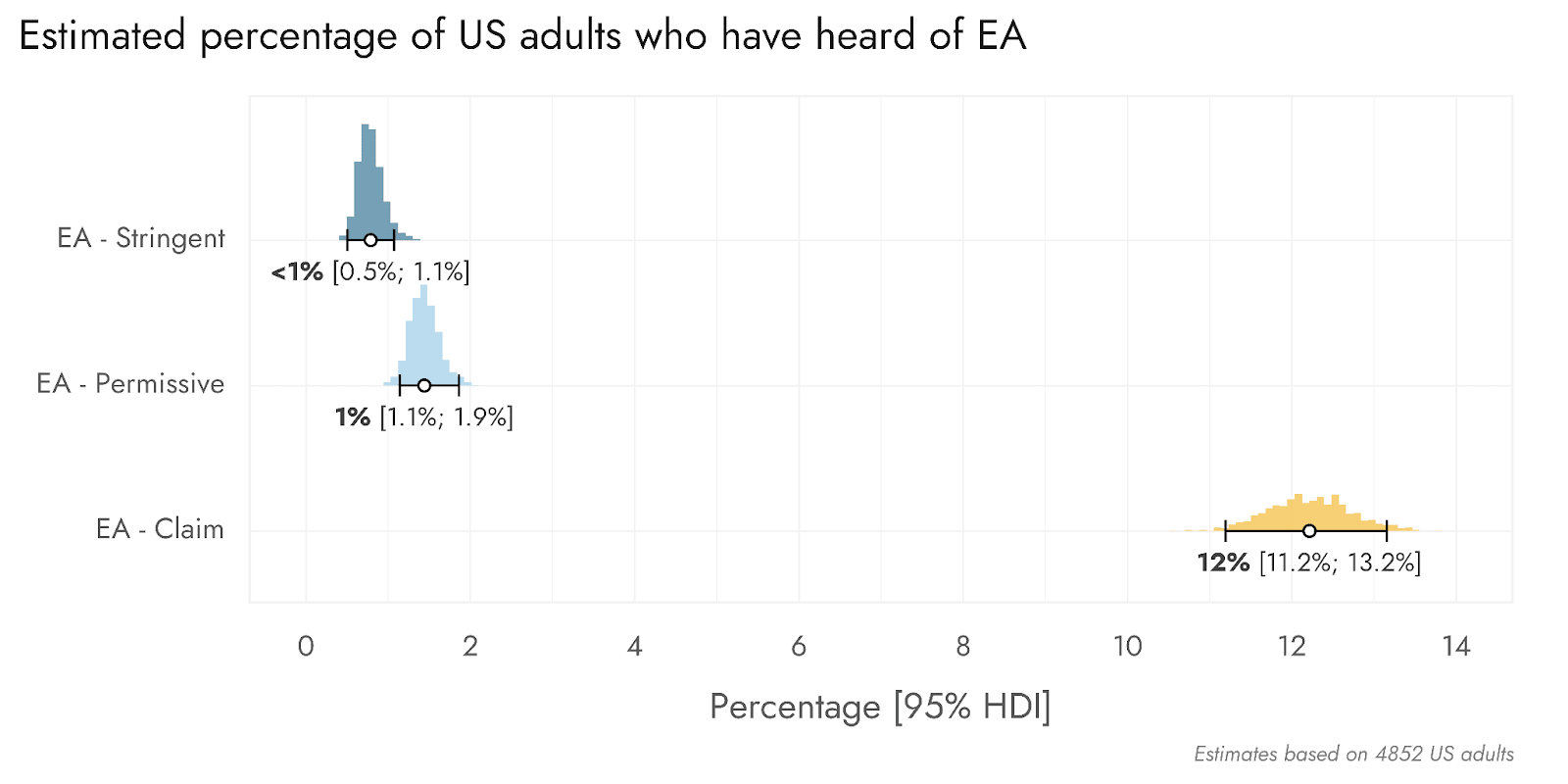
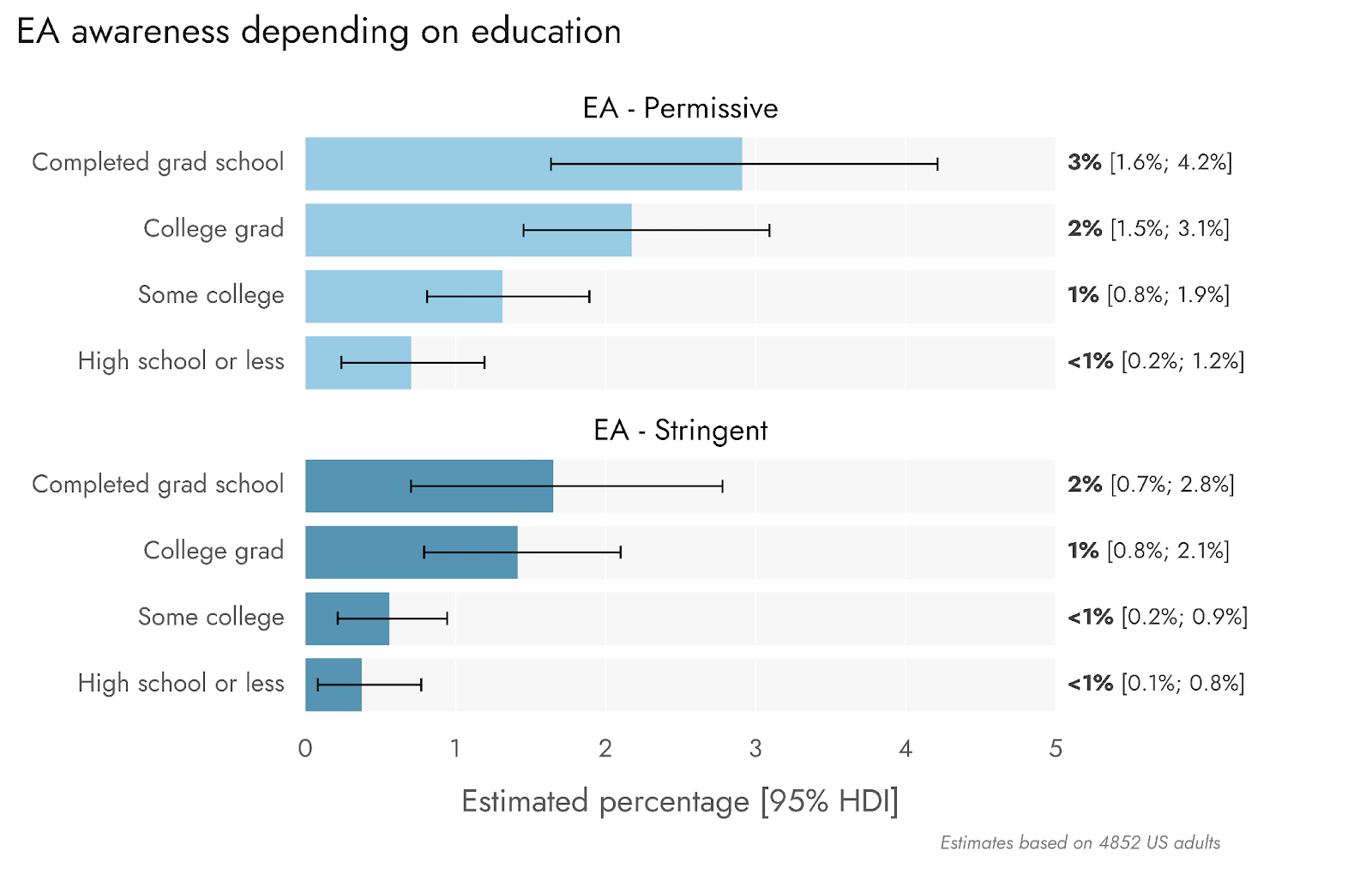
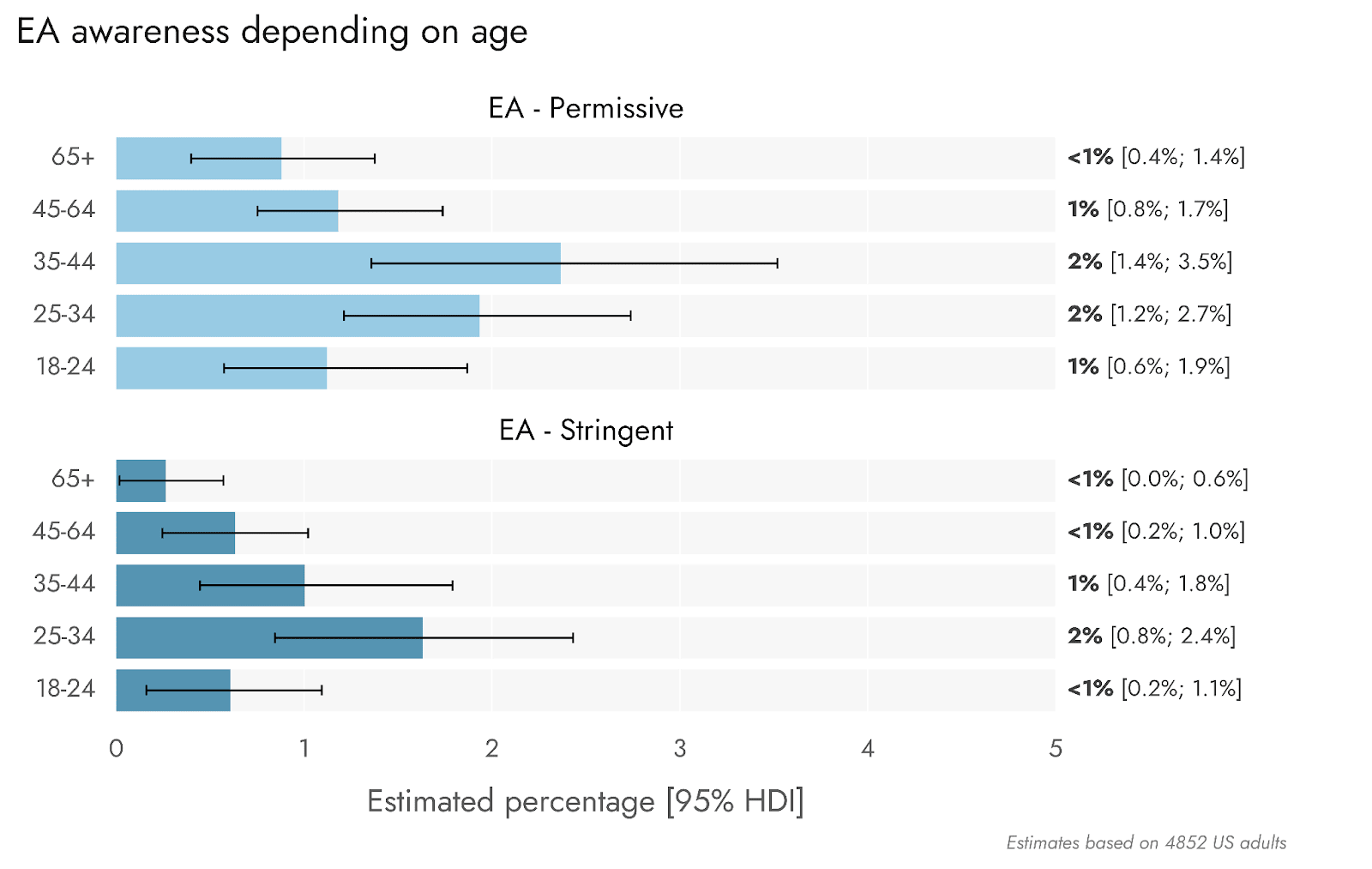
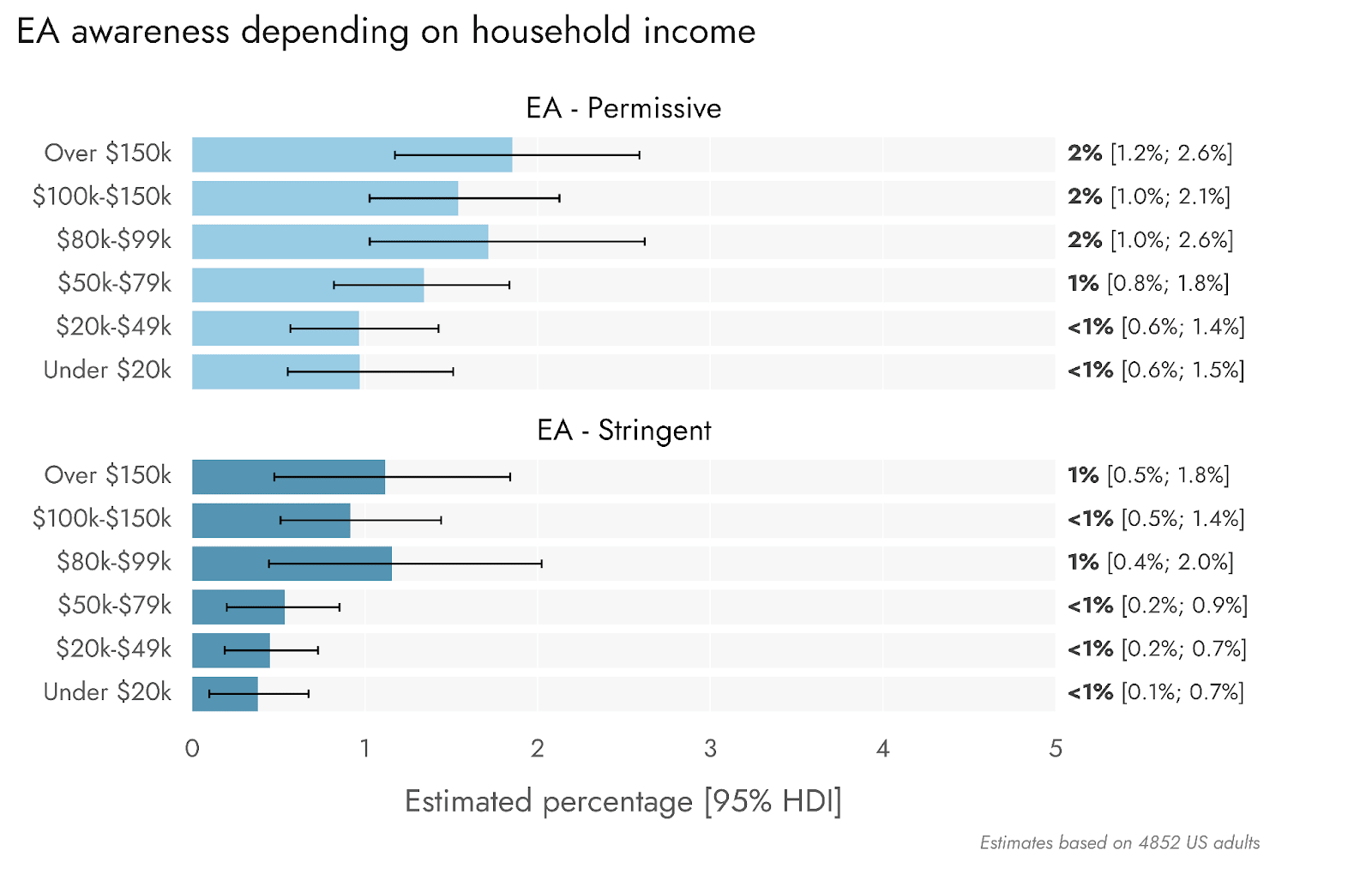
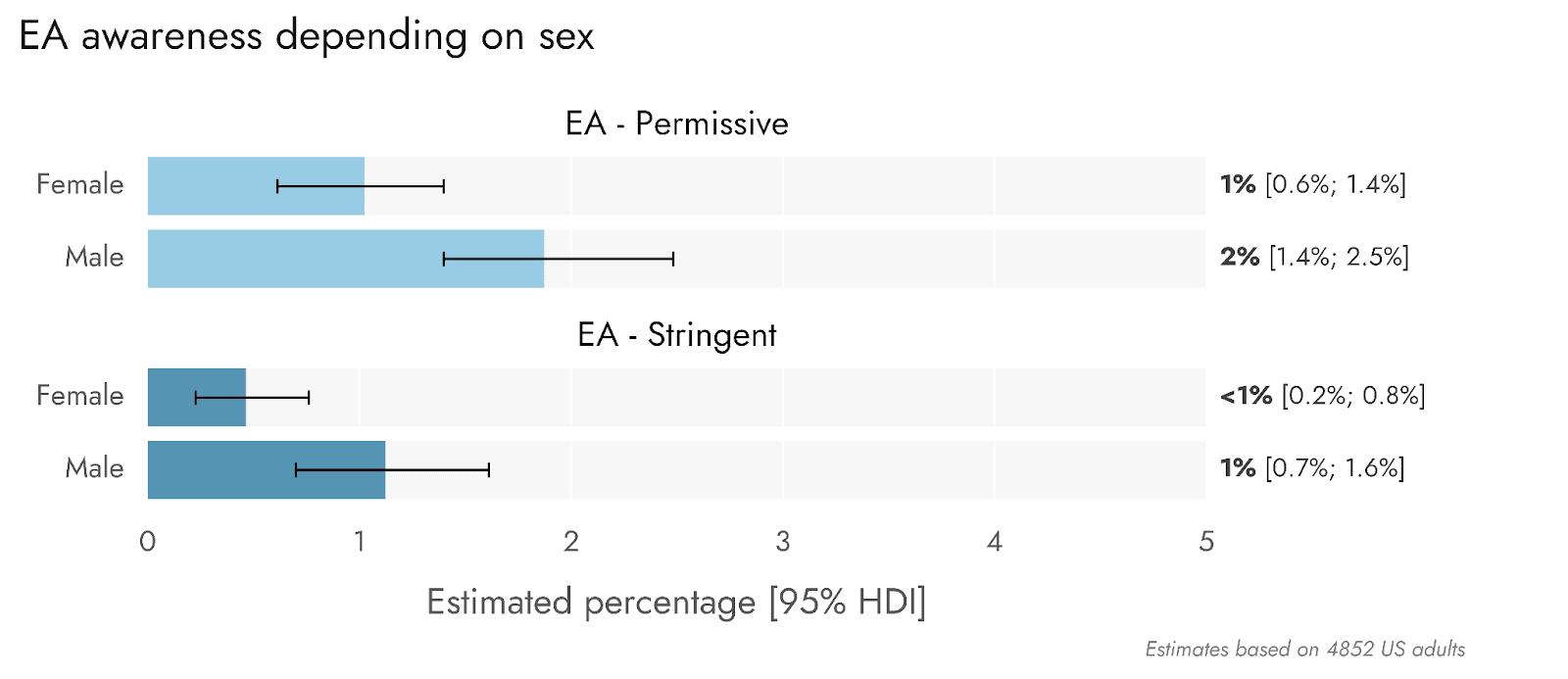
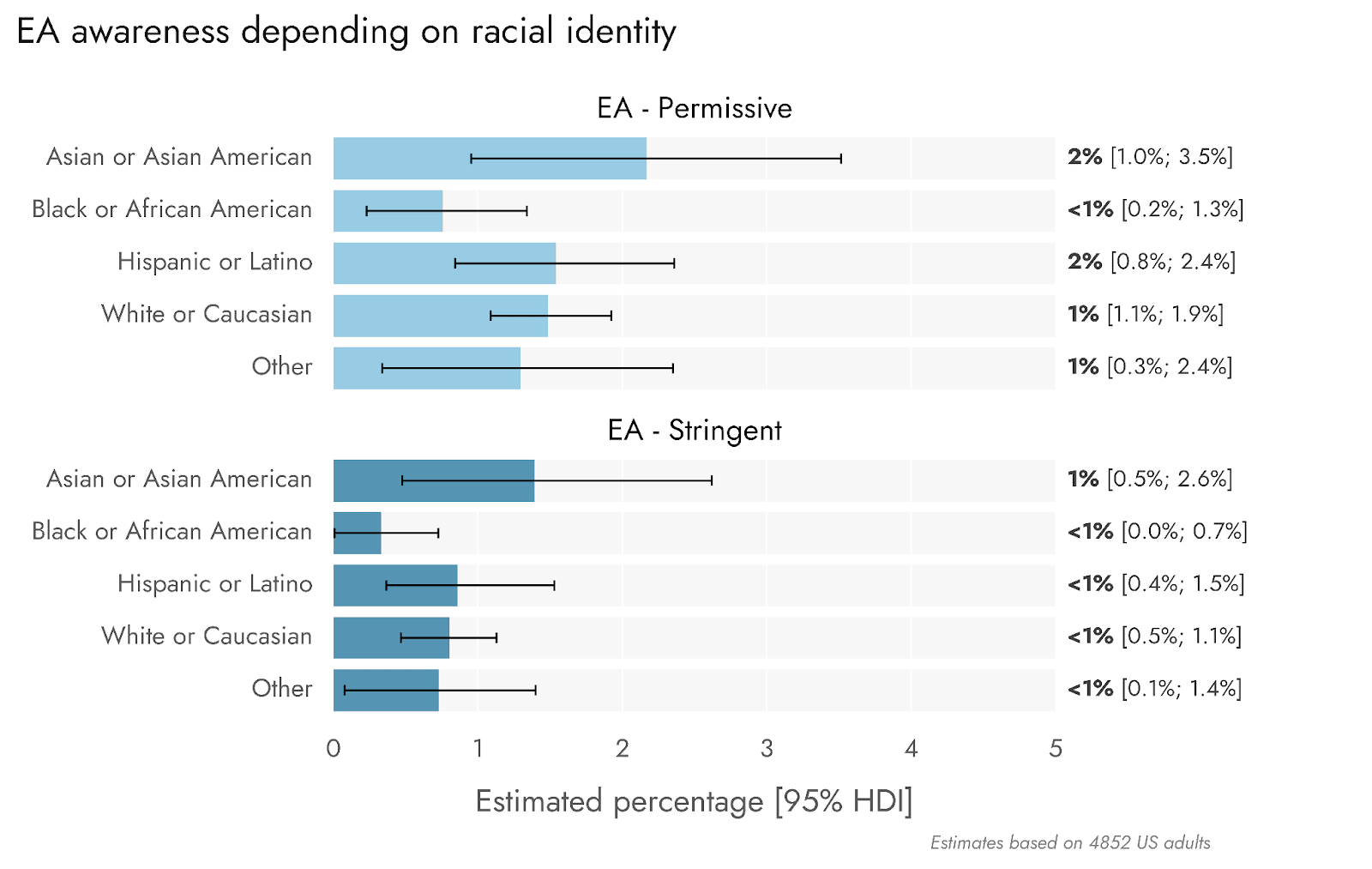
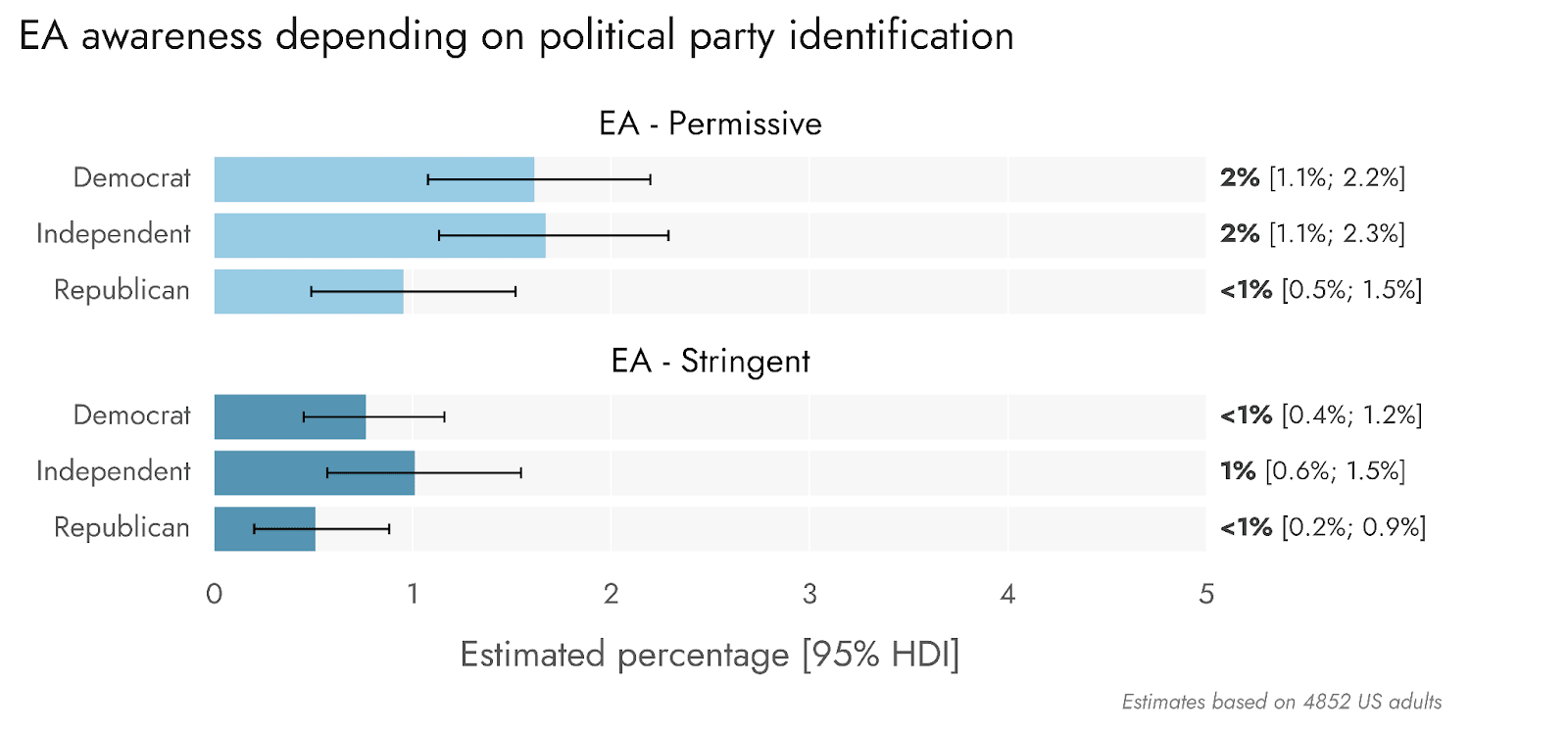
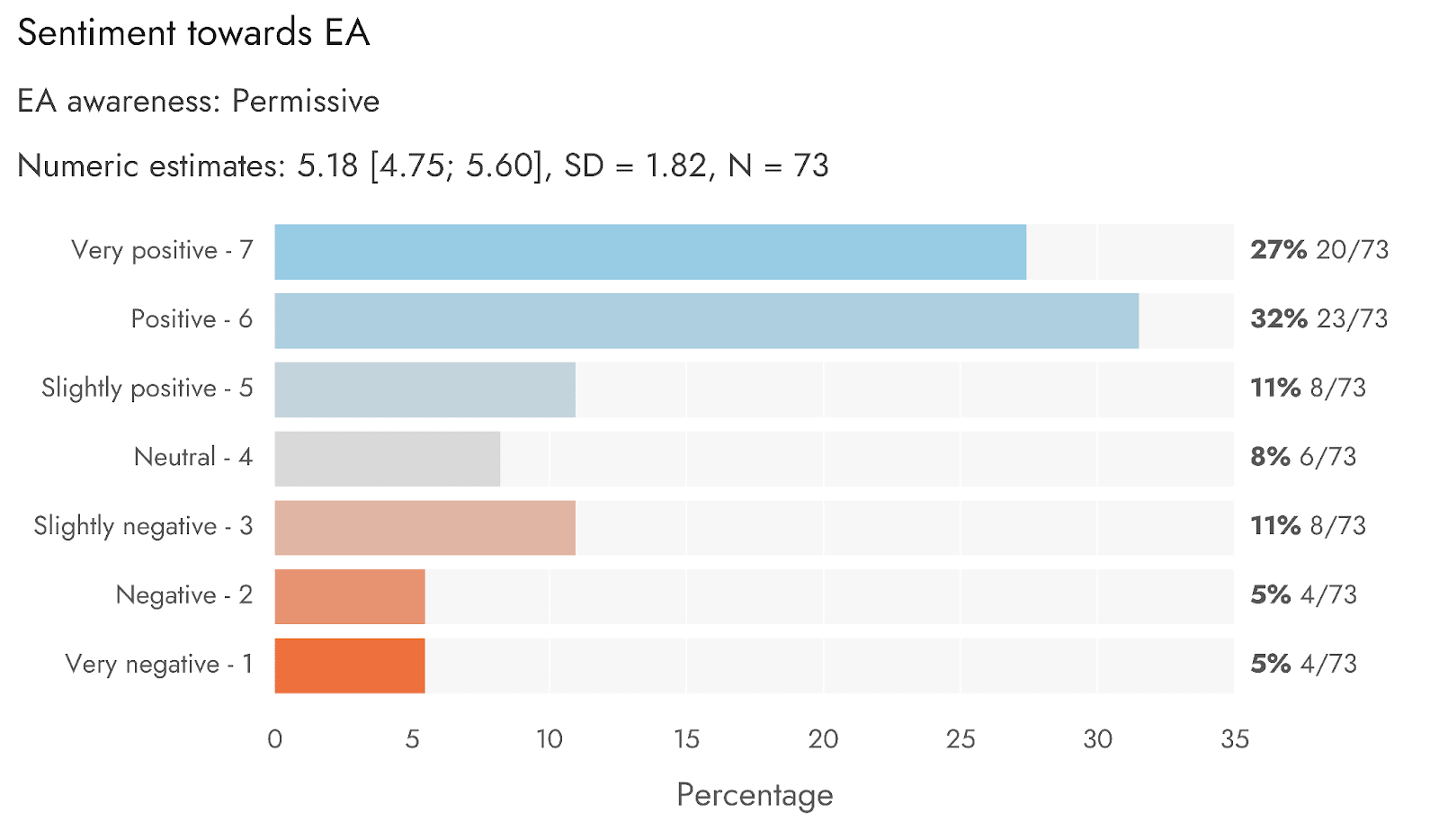
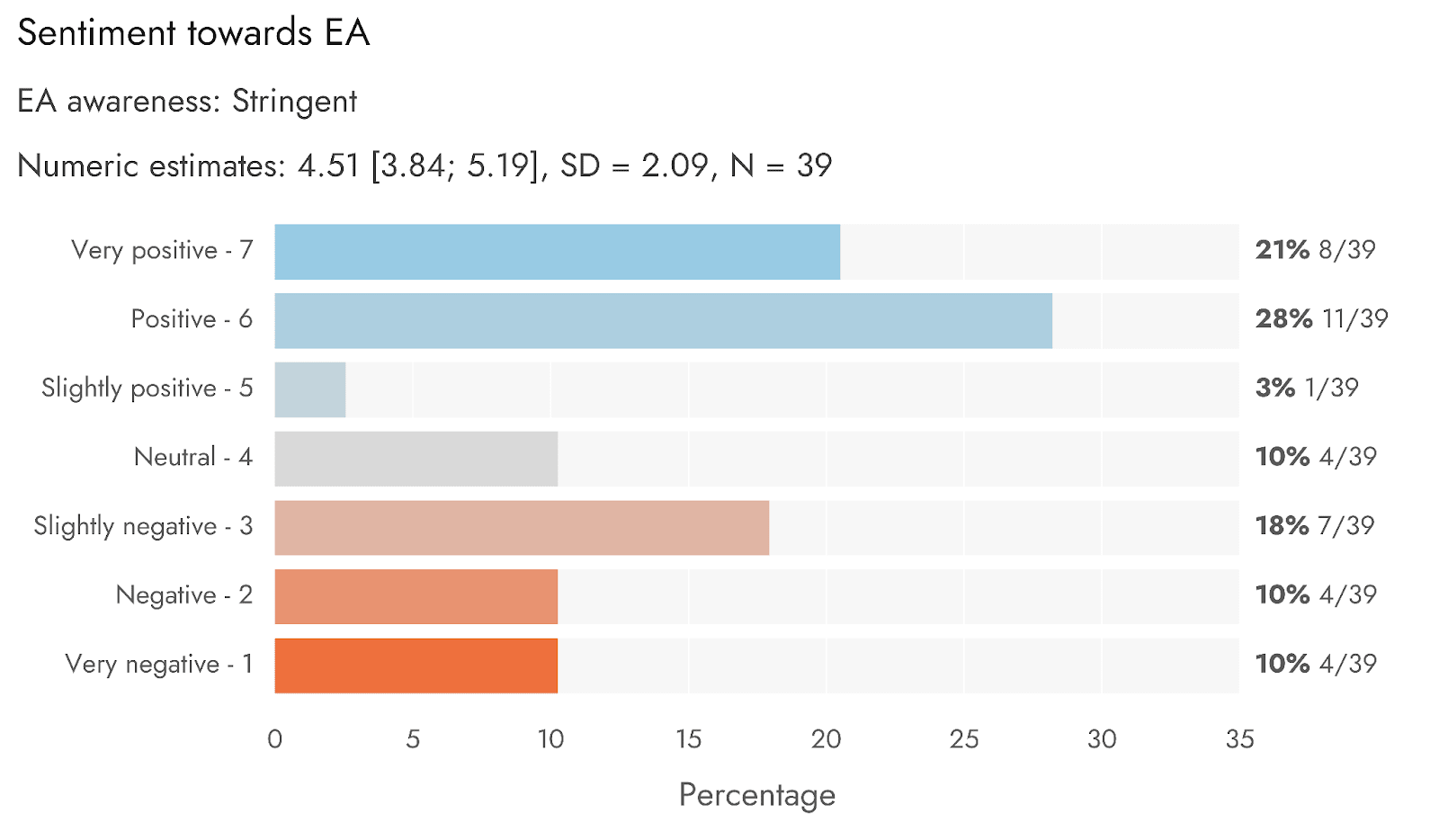
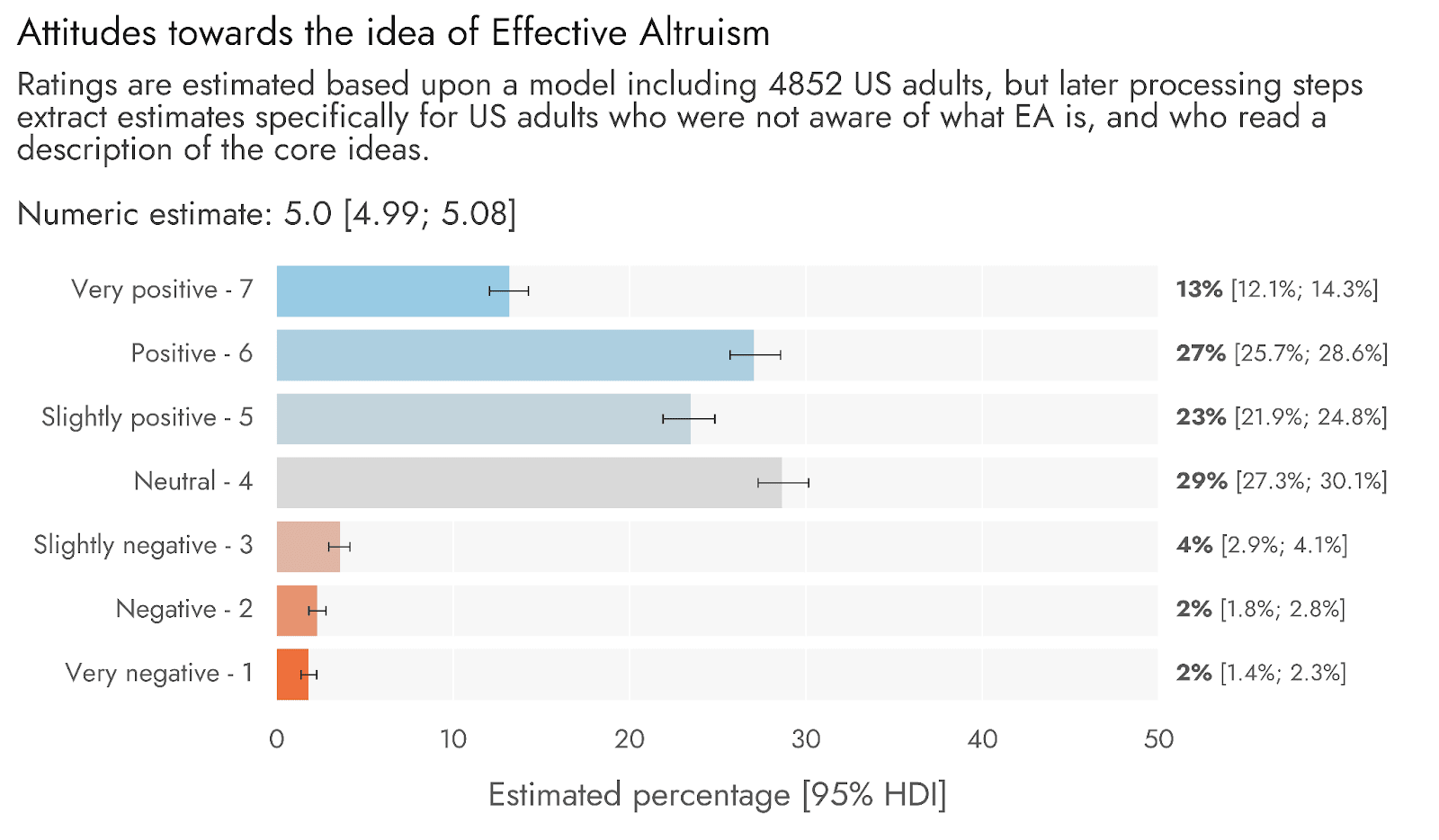
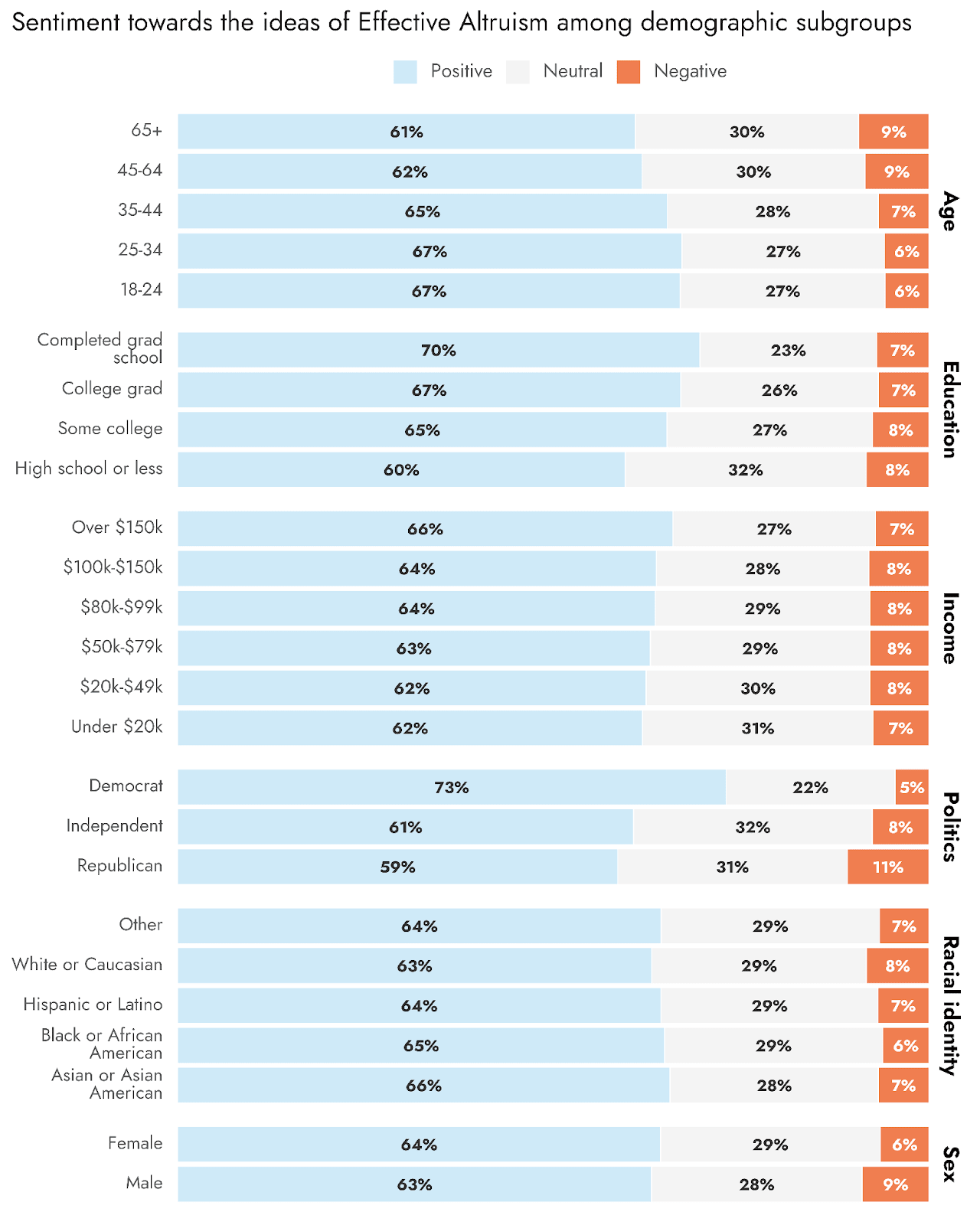
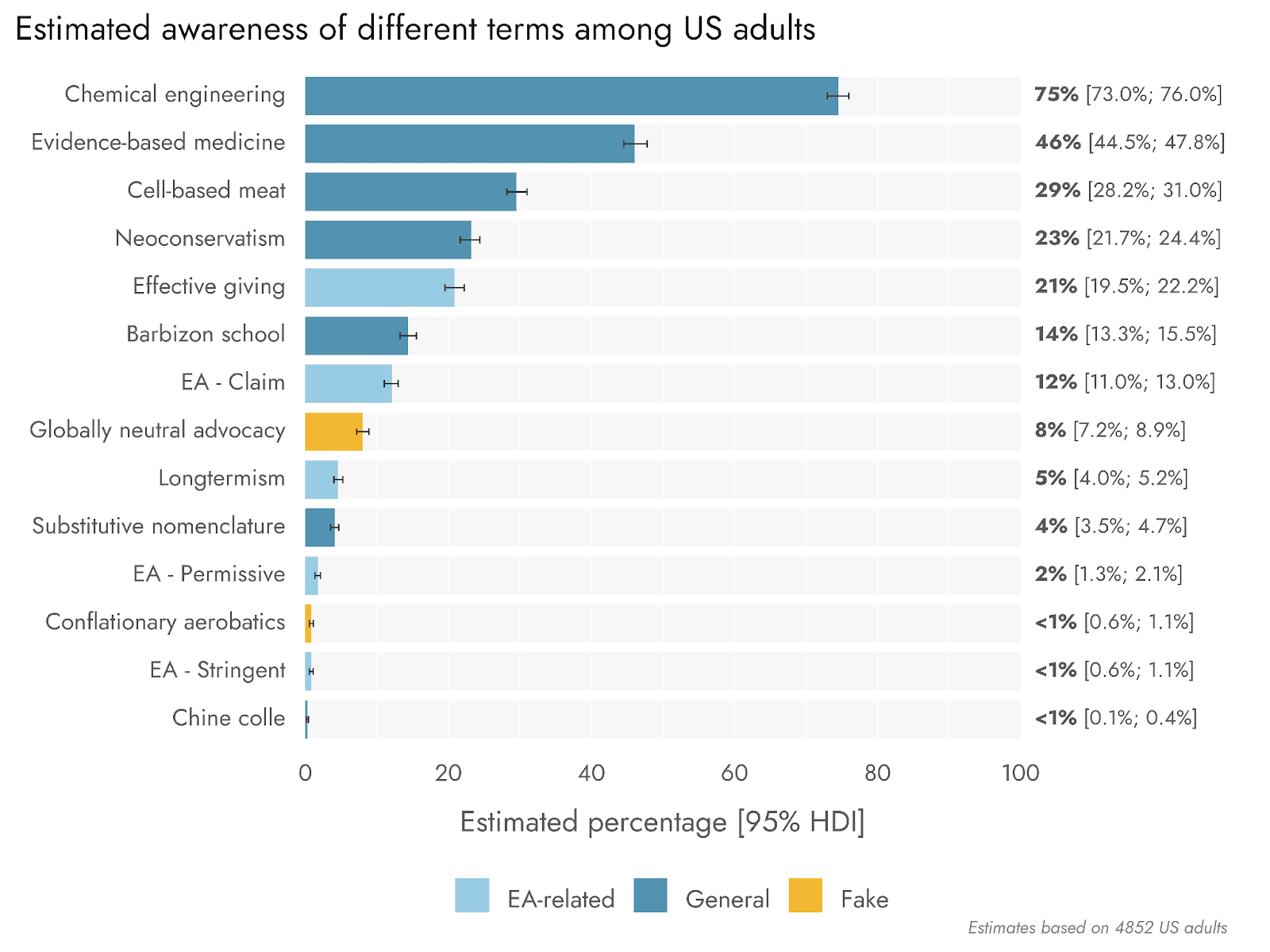
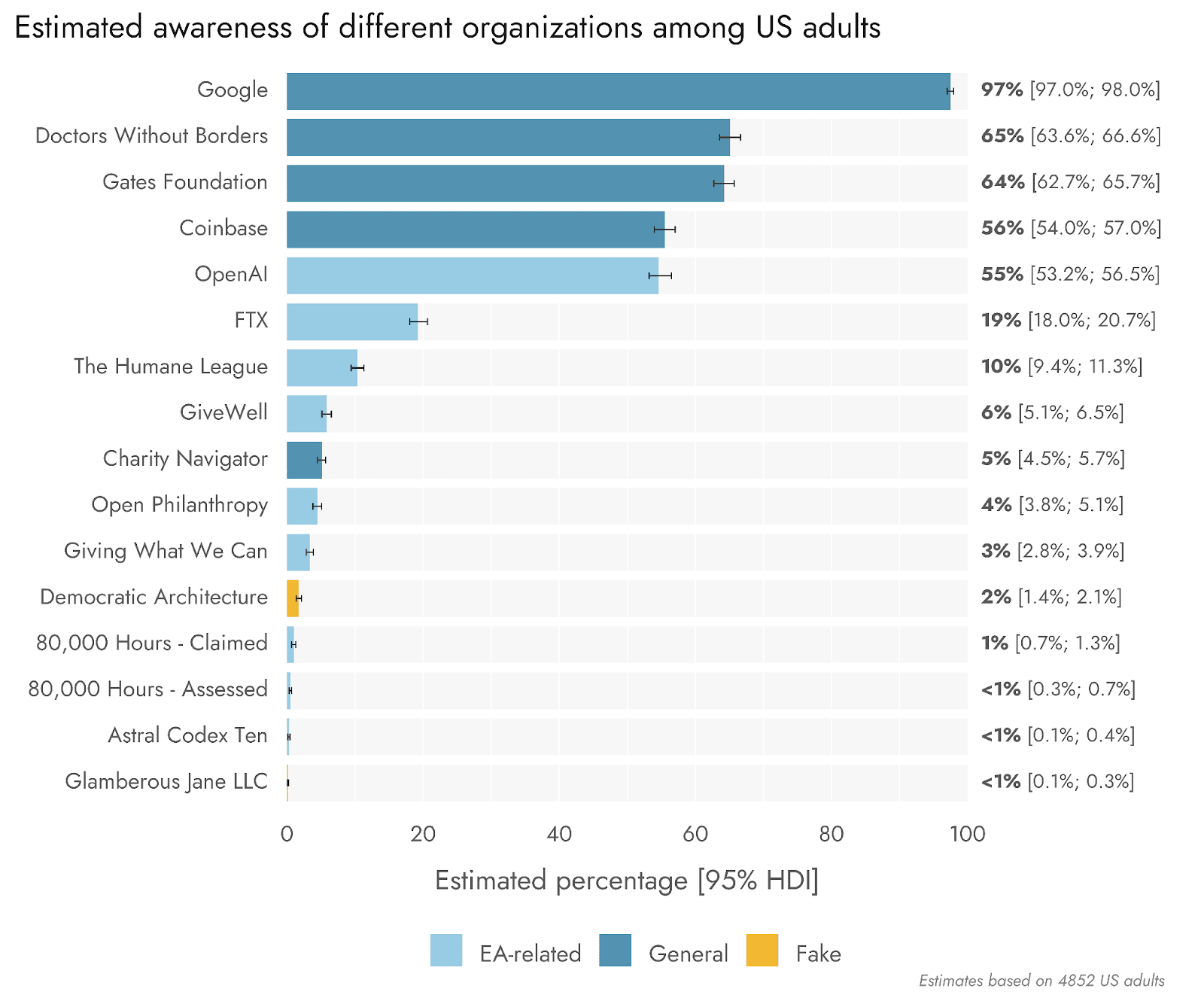
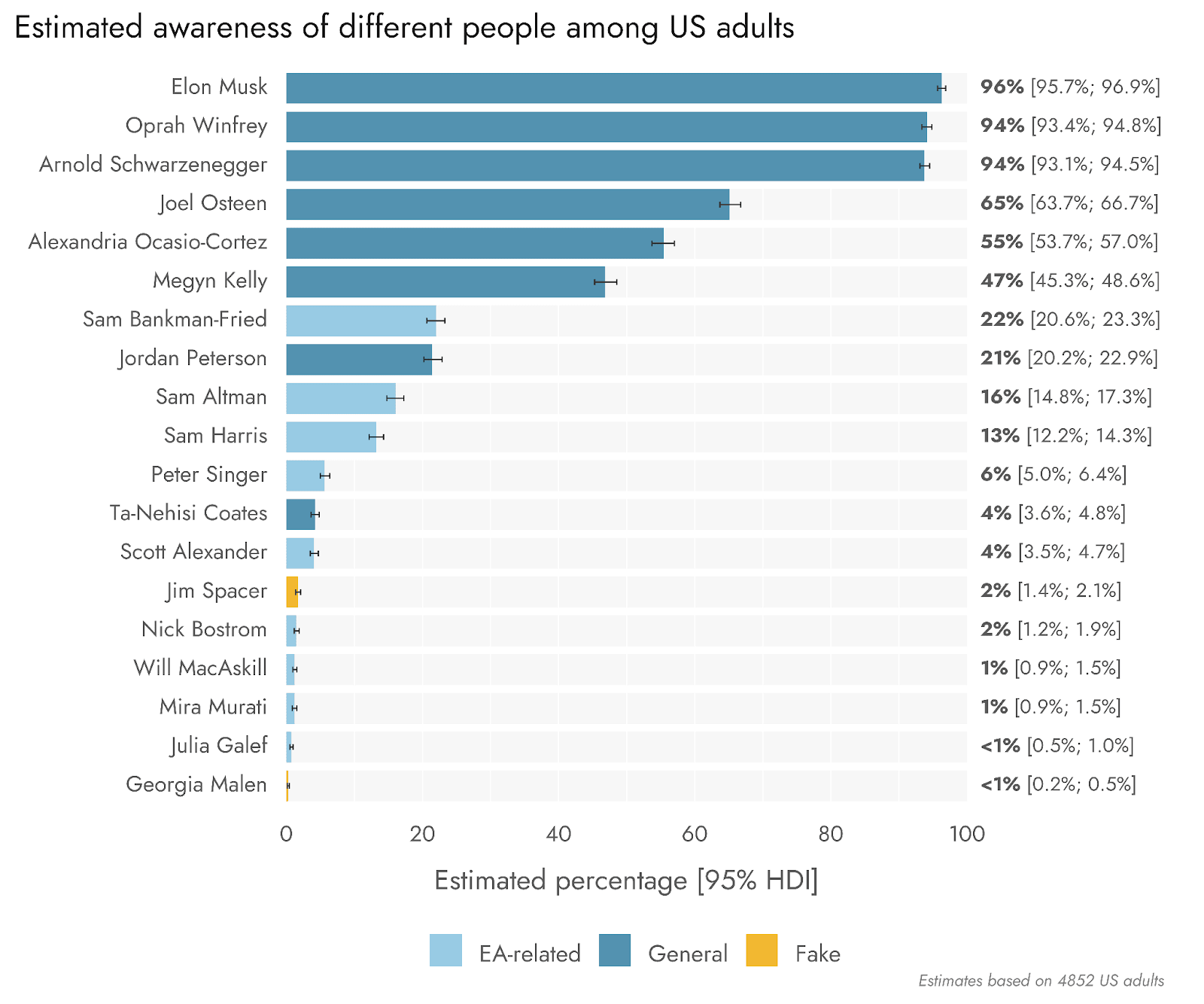

What questions was this survey trying to answer? I kind of feel like the most important version of a survey like this would be certain subsets of people (eg, tech, policy, animal welfare).
Also why didn't you call out that the more people know what EA is, the less they seem to like it? Or was that difference not statistically significant?
("Sentiment towards EA among those who had heard of it was positive (51% positive vs. 38% negative among those stringently aware, and 70% positive, vs. 22% negative among those permissively aware)."
We agree these would be valuable surveys to conduct (and we'd be happy to conduct them if someone wants to fund us to do so). But they'd be very different kinds of surveys. Large representative surveys like this do allow us to generate estimates for relatively niche subsets of the population, but if you are interested in a very small subset of people (e.g. those working in animal welfare), it would be better to run a separate targeted survey.
This comparison wouldn't strictly make sense for a few reasons:
I do think it is noteable that sentiment is more postive among those who did not report awareness of EA, and responded to a particular presentation of EA, compared to sentiment among those who were classified as having encountered EA. However, this is also not a straightforward comparison: the composition of these groups is different, and the people who did not claim awareness were responding only to one particular presentation of EA. More research would be required to assess whether learning more about EA leads to people having more negative opinions about it.
Very detailed and thorough response, thank you!
Last question if you have time: what questions was this survey trying to answer?
Addressing only the results reported in this post, rather than the survey as a whole:
Thanks again! I guess I'm just trying to understand why these metrics are important or how they are important. Why does it matter how many people in the US have heard of EA or how they feel about it? What is the underlying question the survey and its year over-end fellows are trying to get at? Eg, is it trying to measure how well CEA is performing in terms of whether its programs are making a difference in the populace?
I think these questions are relevant in a variety of ways:
One move which is sometimes made to suggest that these things aren't relevant, is to say that we only need to be concerned about awareness and attitudes among certain specific groups (e.g. policymakers or elite students). But even if we think that knowing about awareness and attitudes towards EA among certain groups is highly important, it doesn't suggest that broader public attitudes are not important.
As a practical matter, it's also worth bearing in mind that large representative surveys like this can generate estimate for some niche subgroups, for example, just not really niche ones like elite policymakers), particularly with larger sample sizes.
Just to chime in as someone doing professional community building - these surveys are very useful for all of the reasons David just gave.
This is great, thanks for doing this survey!
Much appreciated Ben!
I am surprised that The Humane League is the most well-recognised EA organisation. Is it possible that some respondents felt as if they recognised it, because they were thinking of new wave band The Human League? I noticed that it wasn’t assessed in the same way as 80k.
I have seen this before, and wondered if it is conflation with Humane Society of the United States (which is often called the Humane Society). Also, many local animal shelters are named "Humane Society". I'd guess this phrase would have very high recognition in the US.
That makes so much more sense, thank you!
Agree that this is likely explained by people thinking they recognise the familiar terms and conflating it with the Humane Society or other local Humane Societies. We didn't include specific checks of real awareness for The Humane League or other orgs and figure on our list, because they weren't key outcomes we were interested in verifying awareness of per se and survey length is limited. They were included primarily to provide a point of comparison (alongside a mixture of fake, real but very low incidence, and real and very common, items), and to allow us another check by assessing whether responses were associated with each other in ways that made sense (i.e. we would expect EA-related terms to show sensible associations with each other, charities in general to be associated with each other, and tech-related items to be associated with each other).
Based on google trends, I'd expect The Humane League to be a bit less well known than GiveWell, and the Humane Society to be much more well known.
Here's the same search, plus The Human League:
Great stuff! Love the idea of throwing red herrings (fake options) in to compare
Very interesting! I love the graphs comparing awareness of different orgs/concepts.
Thanks for putting this together. I found it interesting and useful for my calibration. Will there be a follow-up of a similar design in any other countries? Or another study like this in the US but in a year etc?
Thanks!
Yes, we plan to repeat Pulse at least another three times in the US.
We'd be interested to run it in other countries if there were interest in funding it.
Great! Excited to see the results (at least for the US!).